Mass and Music of Mission Days
Returned to Mission Santa Clara
for an Evening
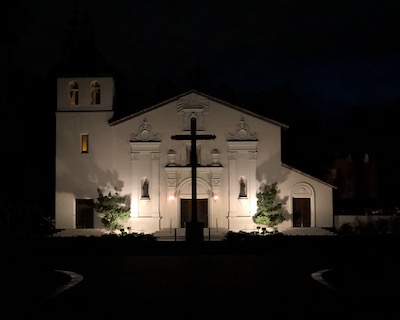
Forty-nine years ago, on the first Sunday of Advent, 1969, the new Mass was introduced to Roman Catholics, and the traditional Latin Mass was virtually banned. Although Pope Benedict freed up its use in 2007, and it has since then been allowed to be celebrated more widely under the name extraordinary form, it is still rare to find extraordinary form Masses celebrated at most Catholic colleges and universities.
Who could then imagine a day would come when an extraordinary form High Mass would be celebrated again at Mission Santa Clara on the Santa Clara University Campus? On November 21, 2018, that day did come.
On the evening before Thanksgiving, Canon Ueda, chaplain of the Immaculate Heart of Mary Oratory in San José, celebrated a Missa Cantata, a sung High Mass, at the Mission Church's otherwise mostly-unused main altar for the first time in anyone’s memory.
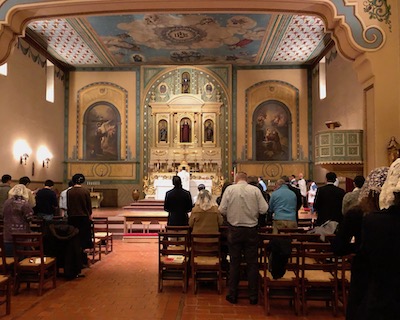
The Mass came about because for the past ten years a group of lay people from the San Jose apostolate of the Institute of Christ the King (formerly the Our Mother of Perpetual Help Oratory in Santa Clara) has organized a commemoration as close as possible to the death anniversary of Father Magin Catalá each year. Father Catalá is the wonder-working missionary who served at the Mission Santa Clara for thirty-six years; he died on November 22, 1830. (An article about last year’s Mass, “The Holy Man of Santa Clara” was published at California Catholic Daily.)
The Mission Santa Clara Church now serves as the Santa Clara University Chapel. Five years ago, the Jesuits who run the university granted permission for one traditional Latin Mass a year. For the last five years, the group arranged a Low Mass, and then finally this year they were able to arrange for their first High Mass, and the first to be celebrated at the Mission’s high altar.
Usually Masses in that chapel are celebrated in the round with chairs with kneelers arranged around a simple altar in the middle of the nave, and the homily is given at a podium with a microphone. Those who set up the High Mass on November 21 needed to redirect the chairs to face the high altar and the liturgical east, and they needed also to bring in candles and altar cloths and Mass cards.
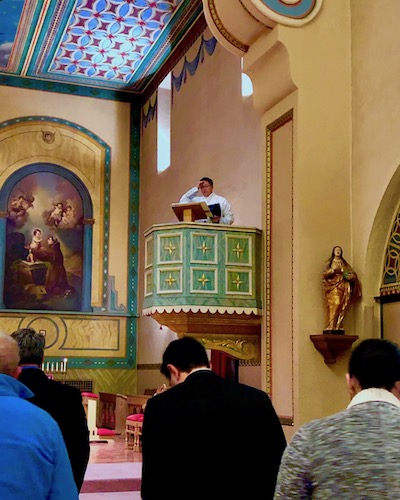
Canon Ueda preached from the usually unused pulpit. Two choirs led by John Vogel from Thomas More School and Michael Hey from Immaculate Heart of Mary Oratory joined to sing the proper chants for the feast of the Presentation of Our Lady.
Especially fitting for the occasion, the combined choir also sang polyphonic (multi-voice) settings for the Ordinary (unchanging parts) of the Mass—which are from a collection of actual music that was taught to the converted native Americans by the Franciscan missionaries. The music for the Kyrie, Gloria, Credo, and Sanctus, which the choir sang November 21, may well have been sung at the Mission Santa Clara back when Father Catalá was alive. (The collection was compiled by Ventura composer John Biggs and published as “California Mission Music” in 1978.)
After the High Mass, the choir also sang the same Latin evening hymn that Father Catalá would lead the converted natives in singing every evening at Vespers.
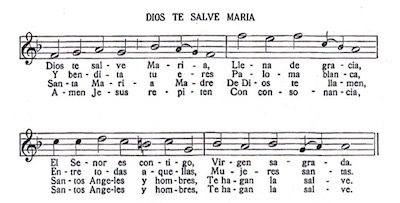
Hail Mary, blessed of God and full of grace,
The Lord is with thee, Purest of our race!
Blest are thou, Dove of purest, spotless white,
Sole woman, never touched by sin’s chill blight!
With one voice earth and heaven thee acclaim
As Queen, — God’s Mother, — Virgin free from stain!
So shall it be! —Forever sound our strain!
With one voice earth and heaven thee acclaim.
Afterwards, attendees moved the side altar called the Catalá altar, which is also called the altar of the crucifix.
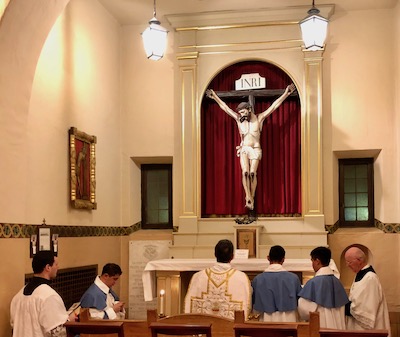
At the side altar, they prayed for Father Catalá’s canonization using a prayer that has been approved by all the bishops from Archbishop Sadoc Alemany, from when the Mission was part of the San Francisco Archdiocese, down to the present Bishop Patrick McGrath of the Diocese of San José, which was divided from the San Francisco Archdiocese and was formed from Santa Clara county.
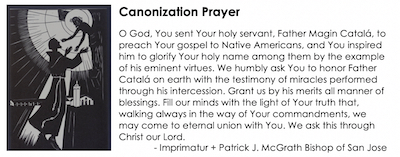
Father Catalá was known for praying many hours at that very same crucifix, sometimes all night long. Witnesses at the canonical hearings for his canonization (the cause for which has stalled since 1909) reported seeing Fr. Catalá levitating in front of that crucifix and that the figure of Christ detached His arms from the cross and embraced the holy friar.
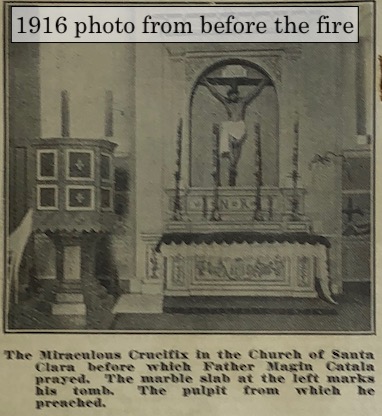
After a fire burned down the church in 1926, Father Catalá’s remains were saved from the ashes and so was the crucifix. Father Catalá’s remains were re-buried in the reconstructed church, at the gospel side of the rebuilt side altar where the crucifix now hangs. A marble grave slab, which used to have gold filling in the letters carved in it and was on the floor in the previous church, is on the wall to the left of the altar.
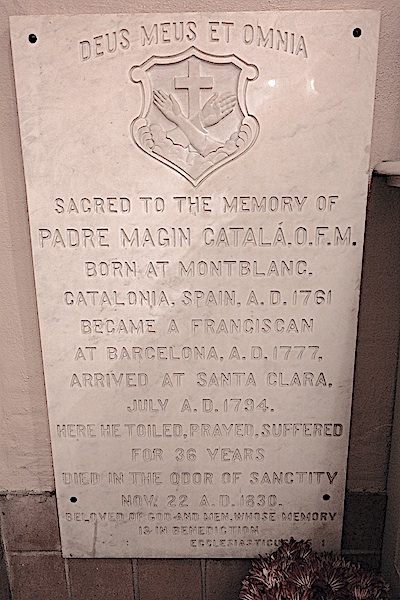
It’s easy to imagine that Father Catalá rejoiced along with the rest of those who were there on that night when through the efforts of a persistent few of his devotees, the reverence and sacred music of the traditional sung Latin High Mass returned for one evening to the beautiful Mission Santa Clara Church.
Galleries
More about Father Catalá's Life and Canonization Cause
- The holy man of Santa Clara; or, Life, virtues and miracles of Fr. Magin Catala, O.F.M. by Fr. Zephyrin Engelhardt in 1909 (free for download PDF),
- Prayer Group for the Canonization of Fr. Magin Catala website,
- And follow Friends of Father Magin Catala, OFM, the Holy Man of Santa Clara on Facebook.
